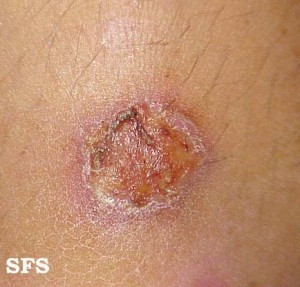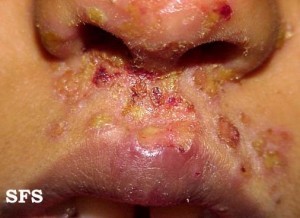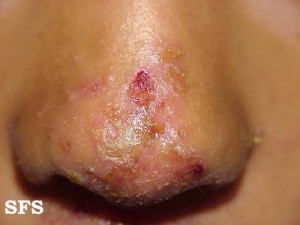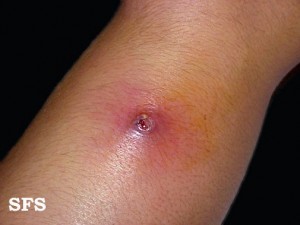Impetigo Skin Infection Causes, Pictures, Treatment
There are many different types of skin infections that can occur and may be caused by various microbes such as bacteria and fungi. Some skin infections are more serious than others. Although the skin is a relatively strong physical barrier to infection, sometimes even minor cuts can allow bacteria to enter and lead to infections like impetigo.
What is impetigo?
Impetigo is a bacterial infection of the skin of the outermost layers of the skin. It is more commonly seen in infants and children and account for as much as 10% of pediatric skin conditions. Impetigo is highly infectious can can progress to serious complications like cellulitis and even kidney disorders if it is severe and left untreated. The condition is contagious and can easily spread among children who are in close contact.
Staphylococci and streptococci are the more common bacteria to cause impetigo. Some of these are naturally occurring bacteria on the skin surface that causes an infection when it gains entry through a cut or injury on the skin. Impetigo can be effectively treated with antibiotics although this may not always be necessary as the infection can resolve on its own within a few weeks.
Types of Impetigo
Impetigo can be classified as nonbullous or bullous.
- Nonbullous impetigo occurs when the body responds the infection. It arises with a break in the skin and is the more common type. The blisters are smaller in this type of impetigo.
- Bullous impetigo occurs even if there is no response of the body to the infection. It is caused by toxins from the infecting bacteria that leads to the formation of larger blisters.
Signs and Symptoms
The signs and symptoms of impetigo typically starts as tiny red blisters with redness of the skin in the infected area. Typically it occurs on the face, arms and legs but can occur anywhere on the body. Eventually the pus-filled blisters rupture and ooze. A thick yellow to brown crust forms on the area over a few days.
The area is usually itchy and becomes tender and painful. If the infection spreads into deeper tissue, ulcers may form. Usually there is enlargement of the lymph nodes in the region. However, other symptoms typical of an infection like a fever may be absent.
Pictures of Impetigo
Causes of Impetigo
A number of different staphylococci and streptococci can cause impetigo. However, the majority of cases are caused by Staphylococcus aureus (S.aureus) and group A beta-hemolytic streptococci (GABHS). S.aureus, S.pyogenes and GABHS cause most cases of nonbullous impetigo while bullous impetigo is caused almost exclusively by S.aureus. Methicillin-resistant Staphylococcus aureus (MRSA) is seen in as many as 20% of bullous impetigo cases.
The skin is able to resist infection even when bacteria like S.aureus colonize the skin although bullous impetigo can occur on intact skin. Impetigo does not only occur with an obvious break in the skin like a cut. It is a superficial infection affecting the outermost layers of the epidermis. The disruption of these outermost layers can occur in a number of different ways including scratching, dermatitis, with viral infections like chickenpox, infestations like scabies, burns, radiation exposure and insect bites. Sometimes the disruption in the skin cannot be seen.
Risk Factors
There are certain risk factors associated with impetigo. Usually it involves a weak immune system as is see with corticosteroid use, diabetes mellitus, HIV infection and other system diseases. Intravenous (IV) drug use also increases the risk of impetigo. The infection is highly contagious and can be spread either directly or indirectly among people who come in close contact with an infected person.
Complications of Impetigo
Impetigo can sometimes progress to complications although the infection can heal on its own even without any treatment. Adults are more likely to experience complications compared to children with impetigo. The more severe complications are seen in people with a weakened immune system, as discussed under risk factors.
The infection can spread to deeper layers of the skin (ecthyma) which can lead to ulcer formation and there may be scarring. Sometimes the infection may spread even deeper into the subcutaneous tissue. This is known as cellulitis and can be life-threatening if not promptly treated.
Acute poststreptococcal glomerulonephritis (a kidney condition) is one of the more common complications that may occur in as many as 20% of impetigo cases. Spread of the infection to the bone (osteomyelitis) or in the bloodstream (sepsis) are rare complications of impetigo.
Treatment of Impetigo
Impetigo can resolve on its own within 2 to 3 weeks even without any medical treatment. Antibiotics are used to treat impetigo. For cases where the infection is localized and there are no complications, topical antibiotics may be administered in the form of ointments. First infected crusts and debris must be removed in order for the topical antibiotics to be able to penetrate the skin. This can be done with soap and water.
When necessary, like in the case of complications or where the impetigo is widespread, oral antibiotics may be administered. It is also used for recurrent cases of impetigo. The entire course of antibiotics that are prescribed must be completed to avoid recurrence. Antibiotic treatment can help speed up the healing from 2 to 3 weeks without treatment to approximately 1 week with treatment.
Prevention of Impetigo
Impetigo is contagious and can easily spread among those in close contact. Therefore children with impetigo should not have close contact with other children until the condition resolves. Simple measures can be effective in preventing impetigo, like keeping the fingernails short and washing the hands regularly with an antibacterial soap.
Breaks in the skin, like cuts and insect bites, should be properly managed by keeping the area clean. Children should be constantly reminded not to scratch the area where a break in the skin occurs. Antiseptics should be applied on the area frequently until the injury heals to prevent bacteria from infecting the site.
Even though impetigo can resolve on its own within a few weeks, assessment by a medical professional is important. Treatment is usually necessary to prevent recurrence and avoid spreading the infection to others in the household.
References:
www.mayoclinic.org/diseases-conditions/impetigo/basics/definition/con-20024185
emedicine.medscape.com/article/965254-overview








